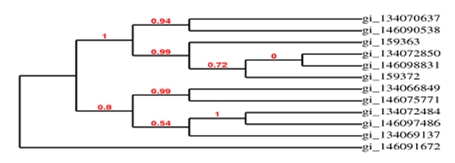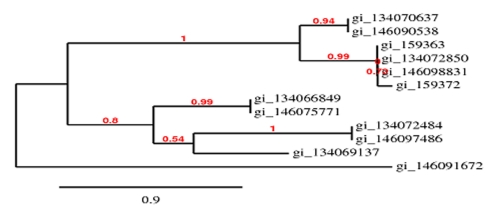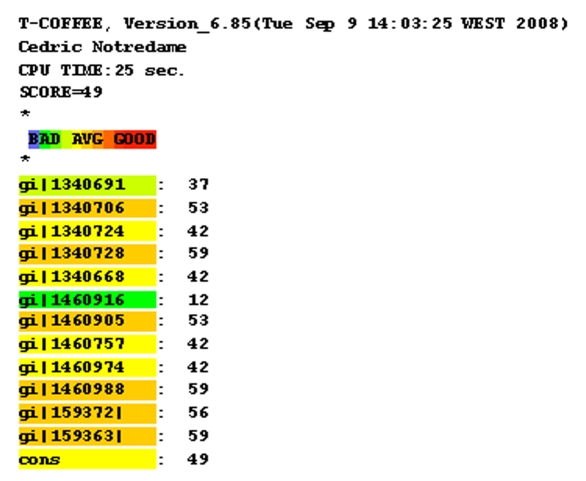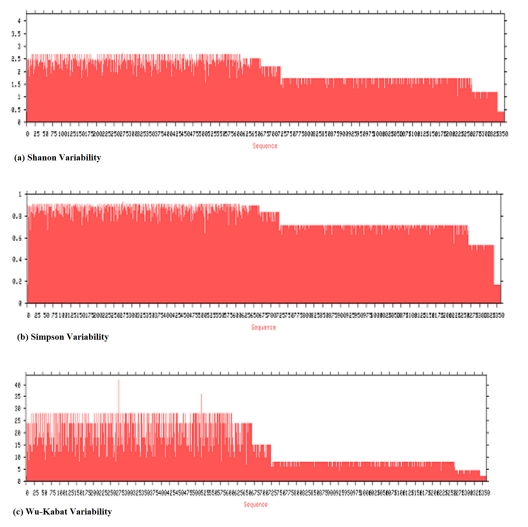Abstract
Visceral Leishmaniasis is a macrophage associated disorder for the treatment of which antimony based drugs like SAG and SSG were the first choice in the recent past. The clinical value of antimony therapy is now declined against VL because increasing cases of Sodium Antimony Gluconate (SAG) resistance have reached outstanding proportion in Bihar, India. Within this context we looked into the protein sequences of ABC transporters of Leishmania spp associated with Visceral Leishmaniasis that are known to play a crucial role in the development of multidrug resistance (MDR). Our studies consisting of ClustalW, Phylogeny and TCOFFEE have pinpointed that ABC transporters have enormously diverged during the process of evolution even within the identical species strains resulting in insignificant homology and subdued conservation amongst the aminoacid residues. Moreover these amino acid residues remain susceptible to mutations in evolutionary era as indicated by high frequency of variations by the variability studies. Hence we predict that during the process of evolution a series of frequent mutations might have led to changes in the ABC transporters favorable to effluxing the drug thereby making the Leishmania species prone to resistance against the efficient first line drug SAG, used for combating VL. This selection has made them to survive efficiently in the adverse circumstances of antimony based antileishmanial therapy regime.
Keywords: Visceral Leishmaniasis (VL), Sodium Antimony Gluconate (SAG), Multiple Drug Resistance (MDR), ATP Binding Cassette (ABC)
Background
Leishmaniasis is a disease caused by protozoan parasites that belong to the genus Leishmania and is transmitted by the bite of certain species of sand fly (subfamily Phlebotominae). Several species of Leishmania are known to give rise to the visceral form of the disease. The “Old World” (Africa, Asia and Europe) species are L. donovani and L. infantum and the “New World” (South America) species is L. chagasi. Along with Brazil, Sudan, and Bangladesh, India contributes to 90% of the global burden of visceral leishmaniasis [1]. In absence of effective vaccines, chemotherapy is the main weapon to control infections. The first-line drug against all forms of Leishmania infection consists of pentavalent antimony (SbV) that contains drugs such as sodium stibogluconate (SSG) and glucantime, despite its requirement for long courses and cardiac toxicity [1]. Unfortunately, the clinical value of antimony therapy is now challenged because an increasing rate of treatment failure is observed in several field sites, and it has reached to epidemic proportion in the state of Bihar, India [2, 3]. The geographic and temporal groupings of SbV treatment failures [4] suggest the emergence of antimony-resistant strains. ATP-binding cassette transporters (ABC-transporter) are members of a protein superfamily that is one of the largest and most ancient families with representatives in all extant phyla from prokaryotes to humans. These are transmembrane proteins that function in the transport of a wide variety of substrates across extra- and intracellular membranes, including metabolic products, lipids, sterols and drugs. ABC-transporters utilize the energy of ATP hydrolysis to transport various substrates across cellular membranes [6]. Expressing cells actively pump substrates out of the cell, which result in a lower rate of substrate accumulation, lower intracellular concentration at steady state, or a faster rate of substrate elimination from cells loaded with the substrate. At least two Leishmania ABC transporters are involved in drug resistance. One is PGPA, which is involved in resistance to arsenic and antimony-containing compounds [7]. Antimonials are the drug of choice against Leishmania infections. Transfection and biochemical studies suggest that PGPA recognizes metals conjugated to thiols [7]. The second ABC transporter is closely related to mammalian P-glycoproteins homologous to MDR1 [7]. Within this context an insight into the mechanism of natural drug resistance could contribute to the development of efficient strategies for monitoring antimony resistance at sites where it is endemic [5]. The present study has been undertaken to look into the possible mechanism of drug resistance during the course of evolution by emphasising the insilico study of protein sequences of ABC transporters.
Methodology
Dataset Creation
In this study, we aligned the protein sequences of ABC transporters of Leishmania spp associated with Visceral Leishmaniasis over with the similar prediction conditions and compared the results obtained. The protein sequences were procured from the National Center for Biotechnology Information (NCBI) through their entrez search. We compared these sequences with different servers consisting of CLUSTAL W, T-COFFEE, Phylogram, Cladogram based on their results and scores they assigned, data was analyzed. Analysis has been performed on the basis of final score given by the server. Furthermore variability amongst the amino acid residues of ABC transporters has been further studied by three different computer generated programs of EXPASY i.e. Shannon variability, Simpson variability and Wu-Kabat variability.
Multiple Sequence Alignment
By Multiple Sequence alignment using Clustal W and T-COFFEE we arranged the twelve different sequences of ABC transporters of Leishmania species associated with Visceral Leishmaniasis obtained from NCBI to identify regions of homology that may be a consequence of functional, structural, or evolutionary relationships. The value S' is derived from the raw alignment score S in which the statistical properties of the scoring system used have been considered. H which is the relative entropy of the target and background residue frequencies was measured so that average information (in bits) available per position that distinguishes an alignment from chance can be compared. High-scoring segment pair of the local alignments with no gaps achieved one of the top alignments. The Probability (P value) has been calculated by relating the observed alignment score S, to the expected distribution of HSP scores from comparisons of random sequences of the same length and composition as the query to the database. The most highly significant P values have been close to 0. Percent Accepted Mutation has been used to quantify the amount of evolutionary change in a protein sequence. A PAM(x) substitution matrix has been looked into scores for each amino acid substitution. Calculations based on the frequency of that substitution in closely related proteins that have experienced a certain amount (x) of evolutionary divergence have been studied. The Expect value (E) described the number of hits we can “expect” to see by chance when searching a database of a particular size. It decreased exponentially as the Score (S) of the match increased. The lower the Evalue, or the closer it is to zero, the more “significant” the match has been. Space was introduced into an alignment to compensate for insertions and deletions in one sequence relative to another during the computation work.
Phylogeny
A phylogenetic tree or evolutionary tree shows the evolutionary relationships among various biological species or other entities that are believed to have a common ancestor. In a phylogenetic tree, each node with descendants represented the most recent common ancestor of the descendants, and the edge lengths in some trees correspond to time estimates. We referred each node as a taxonomic unit.
Protein Variability
We used the following methods to predict the variability in the protein sequences of ABC transporters of Leishmania spp associated with Visceral Leishmaniasis [8]
Shannon Entropy
Shannon entropy analysis is possibly the most sensitive tool to estimate the diversity of a system. For a multiple protein sequence alignment, the Shannon entropy (H) for every position can be determined. H ranges from 0 (only one residue in present at that position) to 4.322 (all 20 residues are equally represented in that position). Typically, positions with H >2.0 are considered variable, whereas those with H < 2 are considered conserved. Highly conserved positions are those with H <1.0.
Simpson Diversity Index
The Simpson index is another diversity index calculated from genotype proportions. This index describes the chance that two genotypes sampled at random and with replacement from a community will be from the same species. The value of this index ranges between 0 and 1, the greater the value, the greater the sample diversity.
Wu-kabat Variability coefficient
The Wu-Kabat variability coefficient is a well-established descriptor of the susceptibility of an amino acid position to evolutionary replacements. It highlights stretches of accentuated amino acid variation.
Discussion
Clustal W (see Table 1) shows lower identities and positives to the order 24% to 32% and 42% to 55% respectively and comparatively higher percentage of gaps to the order 6% to 15% between the ABC transporters of different species of Leishmania causing Visceral Leishmaniasis. Besides Score also has values less than 50 in most of the alignments. Hence it can be inferred that ABC transporters of different species strains of L. donovoni and L. infantum have undergone tremendous mutations thereby leading to much reduced similarity and level of conservation among themselves. Besides they still seem to be undergoing the same phenomenon in the present time as well leading to the development of resistance against SAG. The Cladogram (Figure 1) and Phylogram (Figure 2) analysis also show that the ABC transporters [gi 134070637 and gi 146090538 are closely associated], [gi134072850 and gi 146098831 are closely linked and gi159372, gi159363], [gi 134066849 and gi 146075771, gi134072484 and gi146097486, gi134069137] have remained closely associated during the process of evolution. They have evolved through a common ancestor on a longer time scale during the process of evolution. But gi 146091672 evolved through a different branch and has no similarity with the other transporters during the evolutionary process. Thus the predictability of the MSA result is authenticated by the Cladogram and Phylogram analysis too. T-COFFEE (Figure 3) also shows very little similarity and identity among ABC transporters of Leishmania species. The similarity ranges from less than average to bad (Figure 3) among different species strains associated with Visceral leishmaniasis.
Figure 1.
CLADOGRAM explaning the relative similarity in the ABC transporters of different species strains of leishmania associated with Visceral Lesishmaniasis during the time of evolution. Each sequence has been denoted with gi followed by a number as quoted in NCBI.
Figure 2.
PHYLOGRAM explaining the relative similarity in the ABC transporters of different species strains of leishmania as associated with Visceral Leishmaniasis in evolutionary time scale.Each sequence has been denoted with gi followed by a number as quoted in NCBI.
Figure 3.
T-COFFEE scores of Multiple Sequence Alignment amongst ABC transporters of different species strains of leishmania associated with Visceral Leishmaniasis using Clustal W as an alignment tool..Each sequence has been denoted with gi followed by a number as quoted in NCBI.
Shannon's Entropy (Figure 4a), H has a mean value of around 2 and in a major chunk of the protein sequence of ABC transporters; H is more than 2.5 which advocates a higher variability. Besides much less of the sequences range between 2 and 2.5 which shows little conservation and higher variability. Similarly Simpson diversity index (Figure 4b) has a mean value around 0.8 and Wu Kabat variability coefficient has a mean value of around 16 (Figure 4c) also support that the frequency of variation at a specific amino acid is more both in the genotypic as well as in the phenotypic levels of the considered species strains of leishmania related to visceral leishmaniasis.
Figure 4.
Variablity studies showing the frequency of variation in each amino acid residue during evolution in the ABC transporters of different species strains of leishmania associated with Visceral Leishmaniasis.
Conclusion
As shown by result of MSA the relative similarity between ABC transporters of L. donovani and L. infantum is to the order of less than 50% in most of cases. Similarly Phylogram and Cladogram also predict a low level of similarity between ABC transporters of these species. There is more branching and large distance between the species strains in Phylogram. Moreover T-COFFEE and variability studies also predict minute similarity and identity among the ABC transporters of Leishmania species. During the time of evolution the ABC transporter goes under random mutation as there are remarkable differences within the strains of species. Hence low levels of similarity between results lead us to conclude that evolutionary different types of ABC transporters are present in L. donovani and L. infantum which are prone to mutations. We have to design an inhibitor with multiple binding sites which can block the phenomenon of drug efflux from the ABC transporter thereby keeping the basic structure intact. The inhibition of ABC transporter with resistance modifying agent will allow accumulation of drug SAG (sodium antimony gluconate) and parasite killing within macrophage [9]. Another possible way to circumvent resistance would be to provide a combination therapy consisting of drugs and an inhibitor that has been shown useful in Leishmaniasis. An inhibitor, which can block both PGPA and MRP1, might be beneficial for reverting SAG resistance in leishmaniasis. Hence our focus should be to circumvent the phenomenon of drug efflux by the ABC transporters to enhance the efficiency of drug to be retained by the ABC transporters for a longer duration.
Supplementary material
Acknowledgments
Sukrat Sinha is thankful for the financial support provided by the University Grants Commission, India under Dr. D.S Kothari Postdoctoral Fellowship. Technical help rendered by Dr. Pardeep Kumar, School of Life Sciences, Jawaharlal Nehru University, New Delhi, India in formatting figures is also acknowledged.
Footnotes
Citation:Sinha et al, Bioinformation 6(3): 107-110 (2011)
References
- 1. http://www.who.int/leishmaniasis/en/
- 2.CP Thakur, et al. Am J Trop Med Hyg. 1991;45:435. [Google Scholar]
- 3.TK Jha, et al. BMJ. 1998;316:1200. [Google Scholar]
- 4.G Mandal, et al. Indian J Biochem Biophys. 2009;46:86. [PubMed] [Google Scholar]
- 5.AC Coelho, et al. Antimicrob Agents Chemother. 2007;51:3030. doi: 10.1128/AAC.00404-07. [DOI] [PMC free article] [PubMed] [Google Scholar]
- 6.D Légaré, et al. J Bioenerg Biomembr. 2001;33:469. doi: 10.1023/a:1012870904097. [DOI] [PubMed] [Google Scholar]
- 7.J Mookerjee Basu, et al. Antimicrob Agents Chemother. 2008;52:1080. doi: 10.1128/AAC.01196-07. [DOI] [PMC free article] [PubMed] [Google Scholar]
- 8. http://www.expasy.org/
- 9.C Machuca, et al. Exp Parasitol. 2006;114:1. [Google Scholar]
Associated Data
This section collects any data citations, data availability statements, or supplementary materials included in this article.






